Business Plan: Mobile Car Care Limited - Repair Services in India
VerifiedAdded on 2023/04/23
|65
|15128
|219
Project
AI Summary
This comprehensive business plan outlines the strategy for Mobile Car Care Limited (MCCL), a venture aimed at providing mobile car repair services in India. The plan includes an executive summary, market analysis, competitor analysis, and financial projections. MCCL intends to address the gap in the market for roadside assistance, offering services such as tire changes, light replacements, and fuel delivery. The plan details the company's objectives, problem/opportunity statement, market summary, competitor analysis, and funding strategies including crowd funding and potential NSE listing. The document also covers the business model, market analysis (PESTLE), customer base analysis, pricing model, and skills requirements for the team. The plan projects a three and five-year growth scenario, and concludes with recommendations for future actions and further research to ensure the business's success. The plan provides a detailed overview of the Indian market, the competitive landscape, and the company's approach to providing quality door-step car repair services.

Running head: BUSINESS PLAN
Business Plan
Name of the Student:
Name of the University:
Author Note:
Business Plan
Name of the Student:
Name of the University:
Author Note:
Paraphrase This Document
Need a fresh take? Get an instant paraphrase of this document with our AI Paraphraser
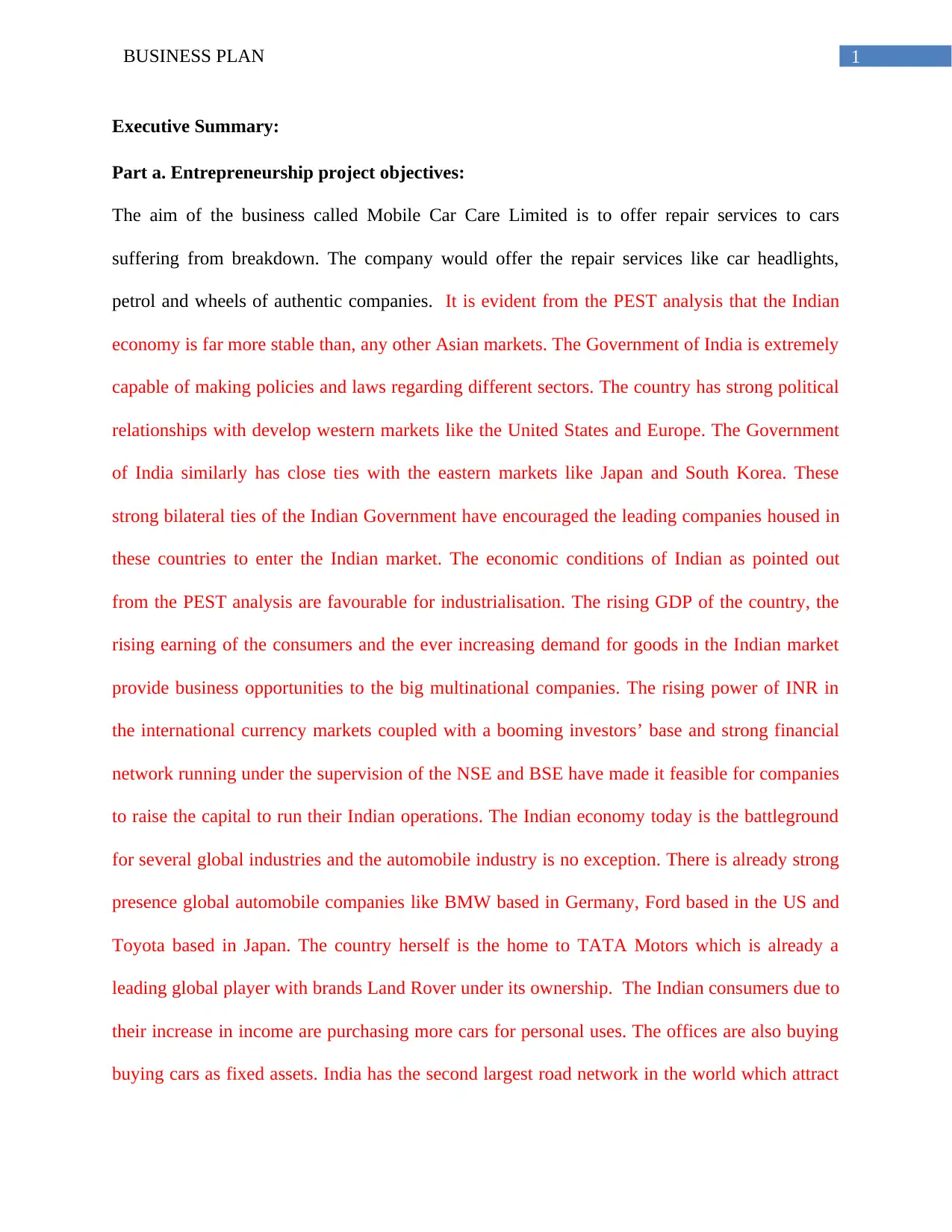
1BUSINESS PLAN
Executive Summary:
Part a. Entrepreneurship project objectives:
The aim of the business called Mobile Car Care Limited is to offer repair services to cars
suffering from breakdown. The company would offer the repair services like car headlights,
petrol and wheels of authentic companies. It is evident from the PEST analysis that the Indian
economy is far more stable than, any other Asian markets. The Government of India is extremely
capable of making policies and laws regarding different sectors. The country has strong political
relationships with develop western markets like the United States and Europe. The Government
of India similarly has close ties with the eastern markets like Japan and South Korea. These
strong bilateral ties of the Indian Government have encouraged the leading companies housed in
these countries to enter the Indian market. The economic conditions of Indian as pointed out
from the PEST analysis are favourable for industrialisation. The rising GDP of the country, the
rising earning of the consumers and the ever increasing demand for goods in the Indian market
provide business opportunities to the big multinational companies. The rising power of INR in
the international currency markets coupled with a booming investors’ base and strong financial
network running under the supervision of the NSE and BSE have made it feasible for companies
to raise the capital to run their Indian operations. The Indian economy today is the battleground
for several global industries and the automobile industry is no exception. There is already strong
presence global automobile companies like BMW based in Germany, Ford based in the US and
Toyota based in Japan. The country herself is the home to TATA Motors which is already a
leading global player with brands Land Rover under its ownership. The Indian consumers due to
their increase in income are purchasing more cars for personal uses. The offices are also buying
buying cars as fixed assets. India has the second largest road network in the world which attract
Executive Summary:
Part a. Entrepreneurship project objectives:
The aim of the business called Mobile Car Care Limited is to offer repair services to cars
suffering from breakdown. The company would offer the repair services like car headlights,
petrol and wheels of authentic companies. It is evident from the PEST analysis that the Indian
economy is far more stable than, any other Asian markets. The Government of India is extremely
capable of making policies and laws regarding different sectors. The country has strong political
relationships with develop western markets like the United States and Europe. The Government
of India similarly has close ties with the eastern markets like Japan and South Korea. These
strong bilateral ties of the Indian Government have encouraged the leading companies housed in
these countries to enter the Indian market. The economic conditions of Indian as pointed out
from the PEST analysis are favourable for industrialisation. The rising GDP of the country, the
rising earning of the consumers and the ever increasing demand for goods in the Indian market
provide business opportunities to the big multinational companies. The rising power of INR in
the international currency markets coupled with a booming investors’ base and strong financial
network running under the supervision of the NSE and BSE have made it feasible for companies
to raise the capital to run their Indian operations. The Indian economy today is the battleground
for several global industries and the automobile industry is no exception. There is already strong
presence global automobile companies like BMW based in Germany, Ford based in the US and
Toyota based in Japan. The country herself is the home to TATA Motors which is already a
leading global player with brands Land Rover under its ownership. The Indian consumers due to
their increase in income are purchasing more cars for personal uses. The offices are also buying
buying cars as fixed assets. India has the second largest road network in the world which attract
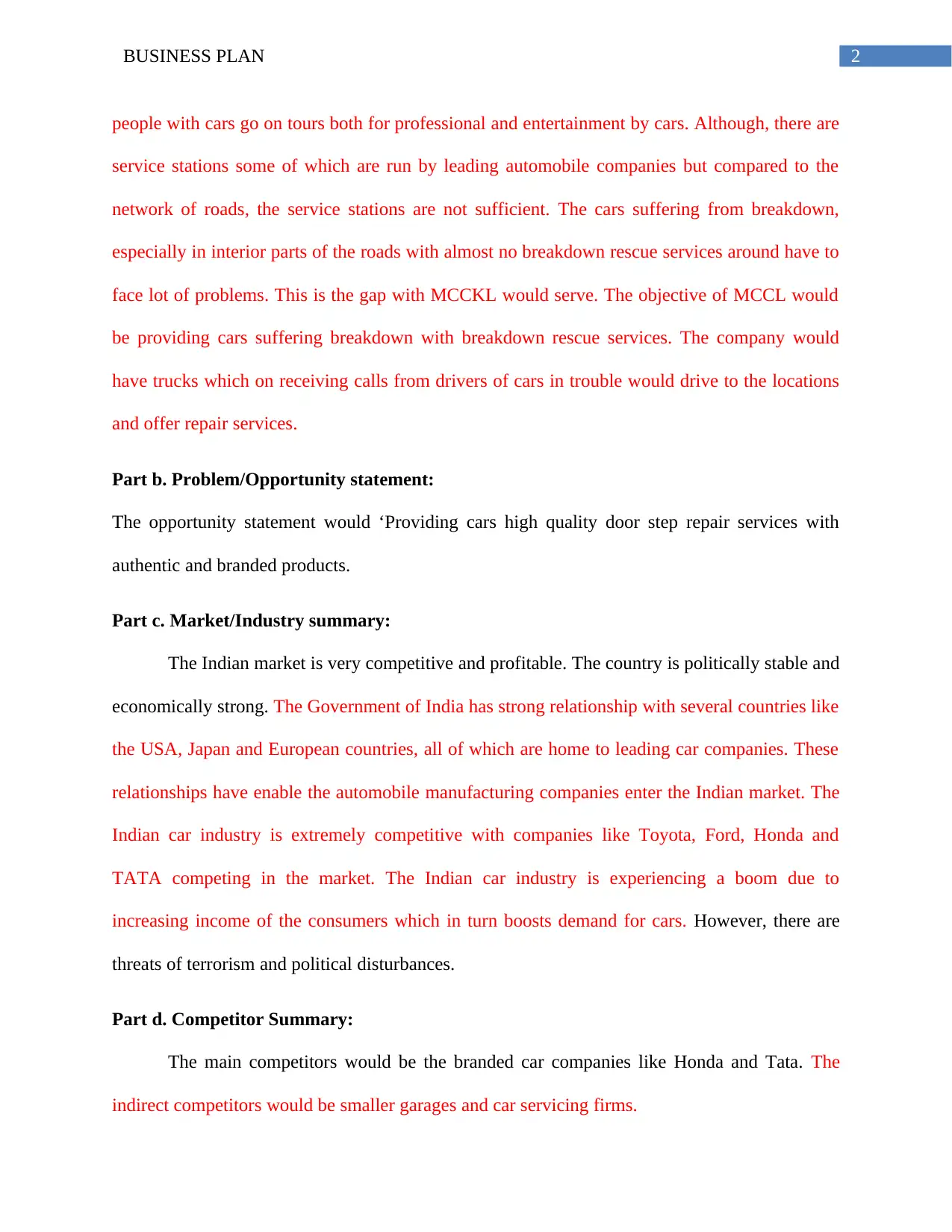
2BUSINESS PLAN
people with cars go on tours both for professional and entertainment by cars. Although, there are
service stations some of which are run by leading automobile companies but compared to the
network of roads, the service stations are not sufficient. The cars suffering from breakdown,
especially in interior parts of the roads with almost no breakdown rescue services around have to
face lot of problems. This is the gap with MCCKL would serve. The objective of MCCL would
be providing cars suffering breakdown with breakdown rescue services. The company would
have trucks which on receiving calls from drivers of cars in trouble would drive to the locations
and offer repair services.
Part b. Problem/Opportunity statement:
The opportunity statement would ‘Providing cars high quality door step repair services with
authentic and branded products.
Part c. Market/Industry summary:
The Indian market is very competitive and profitable. The country is politically stable and
economically strong. The Government of India has strong relationship with several countries like
the USA, Japan and European countries, all of which are home to leading car companies. These
relationships have enable the automobile manufacturing companies enter the Indian market. The
Indian car industry is extremely competitive with companies like Toyota, Ford, Honda and
TATA competing in the market. The Indian car industry is experiencing a boom due to
increasing income of the consumers which in turn boosts demand for cars. However, there are
threats of terrorism and political disturbances.
Part d. Competitor Summary:
The main competitors would be the branded car companies like Honda and Tata. The
indirect competitors would be smaller garages and car servicing firms.
people with cars go on tours both for professional and entertainment by cars. Although, there are
service stations some of which are run by leading automobile companies but compared to the
network of roads, the service stations are not sufficient. The cars suffering from breakdown,
especially in interior parts of the roads with almost no breakdown rescue services around have to
face lot of problems. This is the gap with MCCKL would serve. The objective of MCCL would
be providing cars suffering breakdown with breakdown rescue services. The company would
have trucks which on receiving calls from drivers of cars in trouble would drive to the locations
and offer repair services.
Part b. Problem/Opportunity statement:
The opportunity statement would ‘Providing cars high quality door step repair services with
authentic and branded products.
Part c. Market/Industry summary:
The Indian market is very competitive and profitable. The country is politically stable and
economically strong. The Government of India has strong relationship with several countries like
the USA, Japan and European countries, all of which are home to leading car companies. These
relationships have enable the automobile manufacturing companies enter the Indian market. The
Indian car industry is extremely competitive with companies like Toyota, Ford, Honda and
TATA competing in the market. The Indian car industry is experiencing a boom due to
increasing income of the consumers which in turn boosts demand for cars. However, there are
threats of terrorism and political disturbances.
Part d. Competitor Summary:
The main competitors would be the branded car companies like Honda and Tata. The
indirect competitors would be smaller garages and car servicing firms.
⊘ This is a preview!⊘
Do you want full access?
Subscribe today to unlock all pages.

Trusted by 1+ million students worldwide
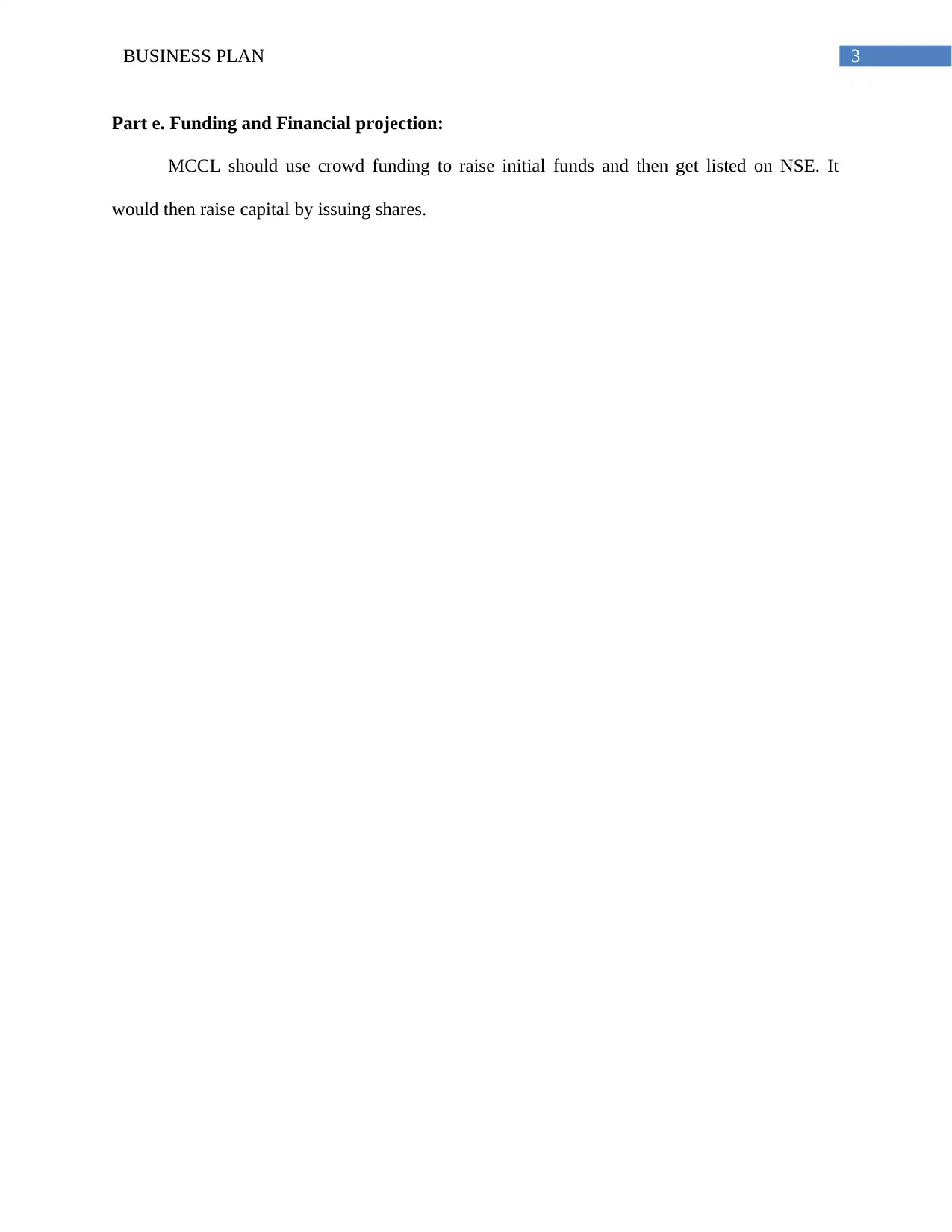
3BUSINESS PLAN
Part e. Funding and Financial projection:
MCCL should use crowd funding to raise initial funds and then get listed on NSE. It
would then raise capital by issuing shares.
Part e. Funding and Financial projection:
MCCL should use crowd funding to raise initial funds and then get listed on NSE. It
would then raise capital by issuing shares.
Paraphrase This Document
Need a fresh take? Get an instant paraphrase of this document with our AI Paraphraser
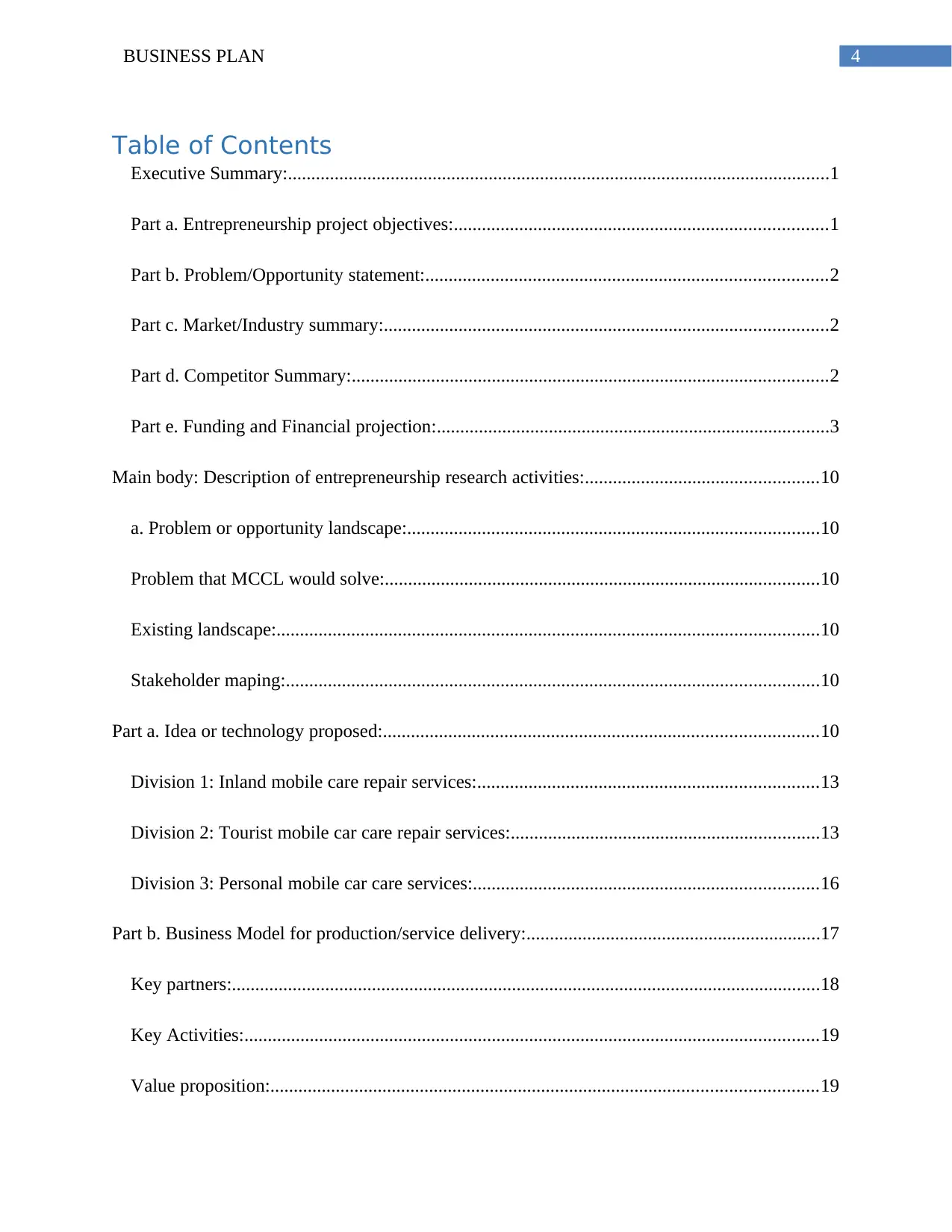
4BUSINESS PLAN
Table of Contents
Executive Summary:....................................................................................................................1
Part a. Entrepreneurship project objectives:................................................................................1
Part b. Problem/Opportunity statement:......................................................................................2
Part c. Market/Industry summary:...............................................................................................2
Part d. Competitor Summary:......................................................................................................2
Part e. Funding and Financial projection:....................................................................................3
Main body: Description of entrepreneurship research activities:..................................................10
a. Problem or opportunity landscape:........................................................................................10
Problem that MCCL would solve:.............................................................................................10
Existing landscape:....................................................................................................................10
Stakeholder maping:..................................................................................................................10
Part a. Idea or technology proposed:.............................................................................................10
Division 1: Inland mobile care repair services:.........................................................................13
Division 2: Tourist mobile car care repair services:..................................................................13
Division 3: Personal mobile car care services:..........................................................................16
Part b. Business Model for production/service delivery:...............................................................17
Key partners:..............................................................................................................................18
Key Activities:...........................................................................................................................19
Value proposition:.....................................................................................................................19
Table of Contents
Executive Summary:....................................................................................................................1
Part a. Entrepreneurship project objectives:................................................................................1
Part b. Problem/Opportunity statement:......................................................................................2
Part c. Market/Industry summary:...............................................................................................2
Part d. Competitor Summary:......................................................................................................2
Part e. Funding and Financial projection:....................................................................................3
Main body: Description of entrepreneurship research activities:..................................................10
a. Problem or opportunity landscape:........................................................................................10
Problem that MCCL would solve:.............................................................................................10
Existing landscape:....................................................................................................................10
Stakeholder maping:..................................................................................................................10
Part a. Idea or technology proposed:.............................................................................................10
Division 1: Inland mobile care repair services:.........................................................................13
Division 2: Tourist mobile car care repair services:..................................................................13
Division 3: Personal mobile car care services:..........................................................................16
Part b. Business Model for production/service delivery:...............................................................17
Key partners:..............................................................................................................................18
Key Activities:...........................................................................................................................19
Value proposition:.....................................................................................................................19
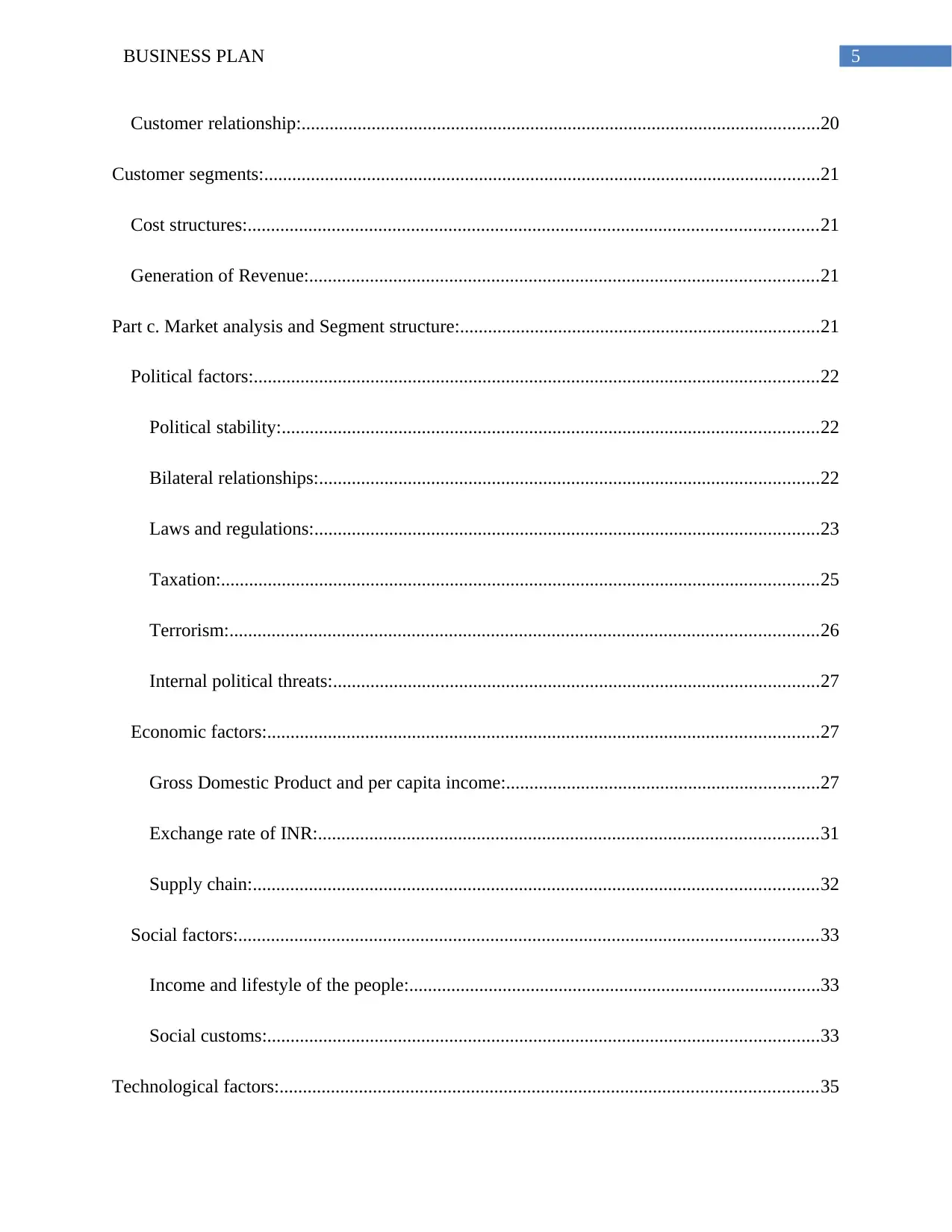
5BUSINESS PLAN
Customer relationship:...............................................................................................................20
Customer segments:.......................................................................................................................21
Cost structures:..........................................................................................................................21
Generation of Revenue:.............................................................................................................21
Part c. Market analysis and Segment structure:.............................................................................21
Political factors:.........................................................................................................................22
Political stability:...................................................................................................................22
Bilateral relationships:...........................................................................................................22
Laws and regulations:............................................................................................................23
Taxation:................................................................................................................................25
Terrorism:..............................................................................................................................26
Internal political threats:........................................................................................................27
Economic factors:......................................................................................................................27
Gross Domestic Product and per capita income:...................................................................27
Exchange rate of INR:...........................................................................................................31
Supply chain:.........................................................................................................................32
Social factors:............................................................................................................................33
Income and lifestyle of the people:........................................................................................33
Social customs:......................................................................................................................33
Technological factors:...................................................................................................................35
Customer relationship:...............................................................................................................20
Customer segments:.......................................................................................................................21
Cost structures:..........................................................................................................................21
Generation of Revenue:.............................................................................................................21
Part c. Market analysis and Segment structure:.............................................................................21
Political factors:.........................................................................................................................22
Political stability:...................................................................................................................22
Bilateral relationships:...........................................................................................................22
Laws and regulations:............................................................................................................23
Taxation:................................................................................................................................25
Terrorism:..............................................................................................................................26
Internal political threats:........................................................................................................27
Economic factors:......................................................................................................................27
Gross Domestic Product and per capita income:...................................................................27
Exchange rate of INR:...........................................................................................................31
Supply chain:.........................................................................................................................32
Social factors:............................................................................................................................33
Income and lifestyle of the people:........................................................................................33
Social customs:......................................................................................................................33
Technological factors:...................................................................................................................35
⊘ This is a preview!⊘
Do you want full access?
Subscribe today to unlock all pages.

Trusted by 1+ million students worldwide
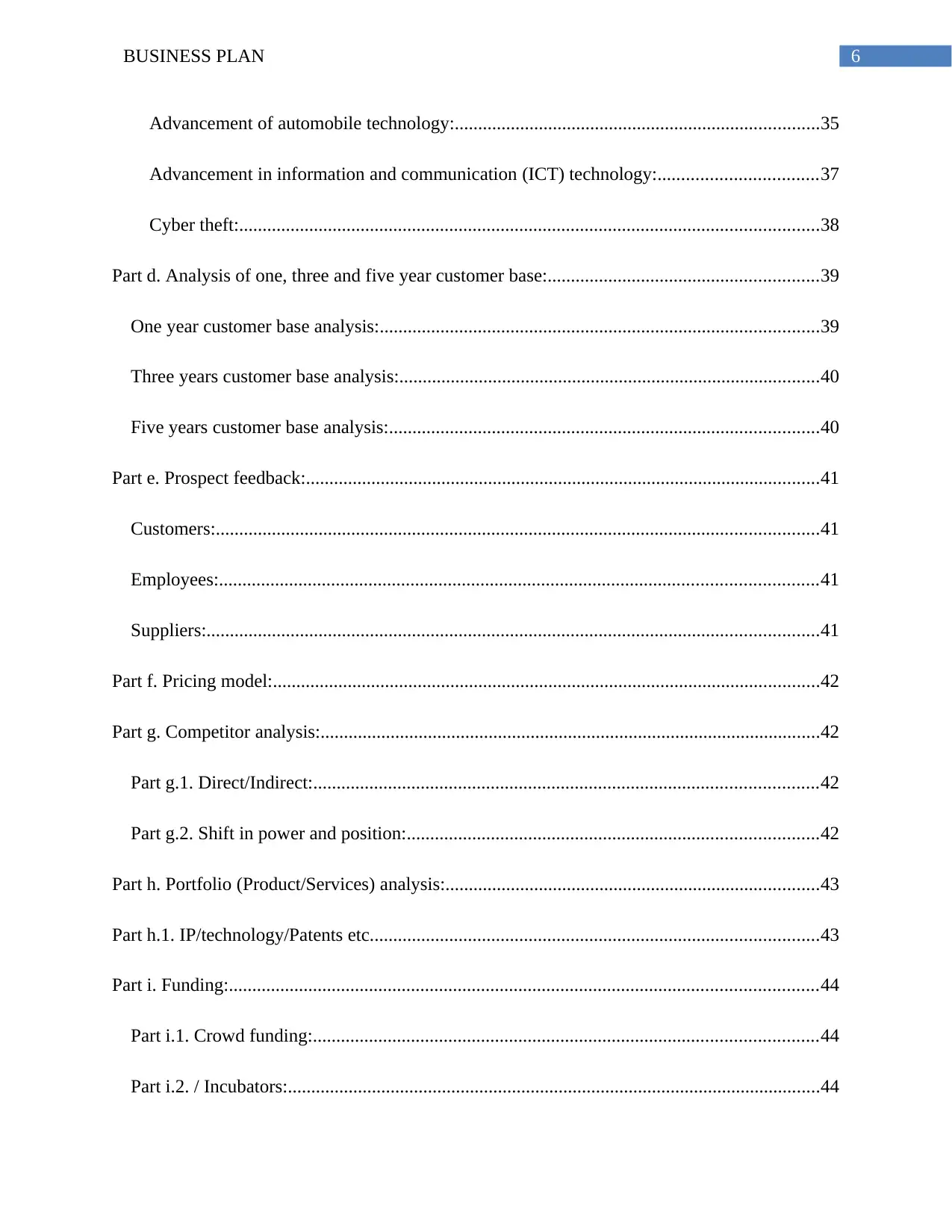
6BUSINESS PLAN
Advancement of automobile technology:..............................................................................35
Advancement in information and communication (ICT) technology:..................................37
Cyber theft:............................................................................................................................38
Part d. Analysis of one, three and five year customer base:..........................................................39
One year customer base analysis:..............................................................................................39
Three years customer base analysis:..........................................................................................40
Five years customer base analysis:............................................................................................40
Part e. Prospect feedback:..............................................................................................................41
Customers:.................................................................................................................................41
Employees:................................................................................................................................41
Suppliers:...................................................................................................................................41
Part f. Pricing model:.....................................................................................................................42
Part g. Competitor analysis:...........................................................................................................42
Part g.1. Direct/Indirect:............................................................................................................42
Part g.2. Shift in power and position:........................................................................................42
Part h. Portfolio (Product/Services) analysis:................................................................................43
Part h.1. IP/technology/Patents etc................................................................................................43
Part i. Funding:..............................................................................................................................44
Part i.1. Crowd funding:............................................................................................................44
Part i.2. / Incubators:..................................................................................................................44
Advancement of automobile technology:..............................................................................35
Advancement in information and communication (ICT) technology:..................................37
Cyber theft:............................................................................................................................38
Part d. Analysis of one, three and five year customer base:..........................................................39
One year customer base analysis:..............................................................................................39
Three years customer base analysis:..........................................................................................40
Five years customer base analysis:............................................................................................40
Part e. Prospect feedback:..............................................................................................................41
Customers:.................................................................................................................................41
Employees:................................................................................................................................41
Suppliers:...................................................................................................................................41
Part f. Pricing model:.....................................................................................................................42
Part g. Competitor analysis:...........................................................................................................42
Part g.1. Direct/Indirect:............................................................................................................42
Part g.2. Shift in power and position:........................................................................................42
Part h. Portfolio (Product/Services) analysis:................................................................................43
Part h.1. IP/technology/Patents etc................................................................................................43
Part i. Funding:..............................................................................................................................44
Part i.1. Crowd funding:............................................................................................................44
Part i.2. / Incubators:..................................................................................................................44
Paraphrase This Document
Need a fresh take? Get an instant paraphrase of this document with our AI Paraphraser
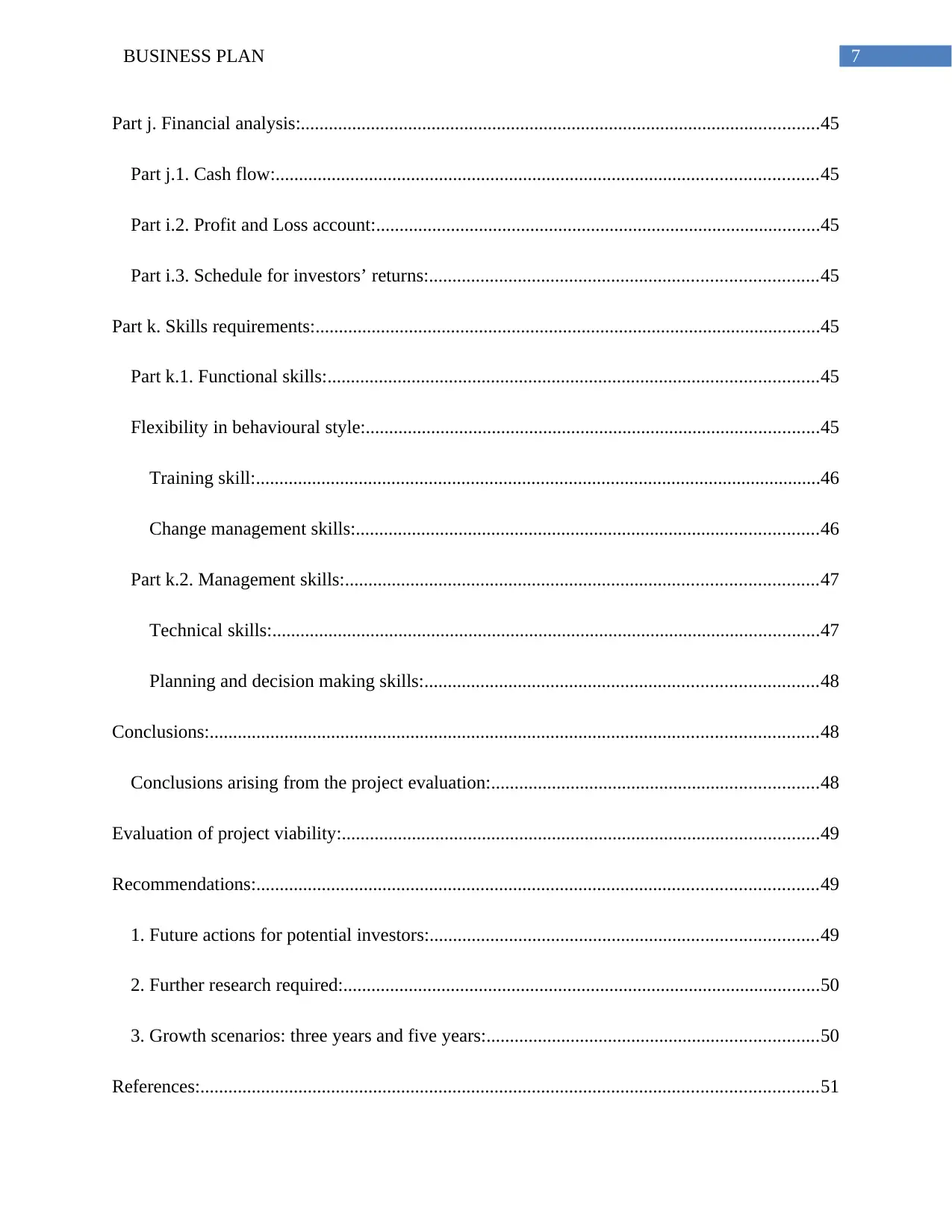
7BUSINESS PLAN
Part j. Financial analysis:...............................................................................................................45
Part j.1. Cash flow:....................................................................................................................45
Part i.2. Profit and Loss account:...............................................................................................45
Part i.3. Schedule for investors’ returns:...................................................................................45
Part k. Skills requirements:............................................................................................................45
Part k.1. Functional skills:.........................................................................................................45
Flexibility in behavioural style:.................................................................................................45
Training skill:.........................................................................................................................46
Change management skills:...................................................................................................46
Part k.2. Management skills:.....................................................................................................47
Technical skills:.....................................................................................................................47
Planning and decision making skills:....................................................................................48
Conclusions:..................................................................................................................................48
Conclusions arising from the project evaluation:......................................................................48
Evaluation of project viability:......................................................................................................49
Recommendations:........................................................................................................................49
1. Future actions for potential investors:...................................................................................49
2. Further research required:......................................................................................................50
3. Growth scenarios: three years and five years:.......................................................................50
References:....................................................................................................................................51
Part j. Financial analysis:...............................................................................................................45
Part j.1. Cash flow:....................................................................................................................45
Part i.2. Profit and Loss account:...............................................................................................45
Part i.3. Schedule for investors’ returns:...................................................................................45
Part k. Skills requirements:............................................................................................................45
Part k.1. Functional skills:.........................................................................................................45
Flexibility in behavioural style:.................................................................................................45
Training skill:.........................................................................................................................46
Change management skills:...................................................................................................46
Part k.2. Management skills:.....................................................................................................47
Technical skills:.....................................................................................................................47
Planning and decision making skills:....................................................................................48
Conclusions:..................................................................................................................................48
Conclusions arising from the project evaluation:......................................................................48
Evaluation of project viability:......................................................................................................49
Recommendations:........................................................................................................................49
1. Future actions for potential investors:...................................................................................49
2. Further research required:......................................................................................................50
3. Growth scenarios: three years and five years:.......................................................................50
References:....................................................................................................................................51
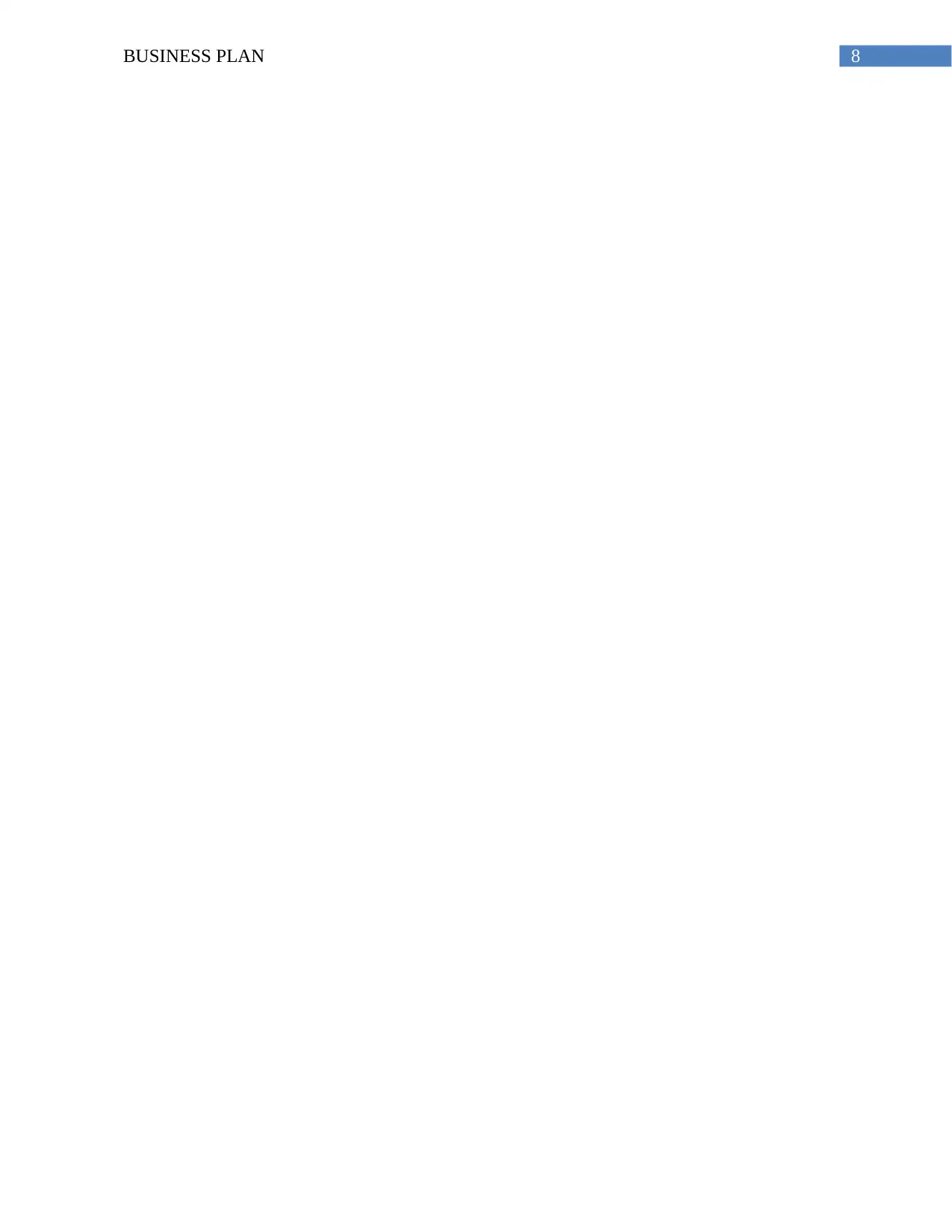
8BUSINESS PLAN
⊘ This is a preview!⊘
Do you want full access?
Subscribe today to unlock all pages.

Trusted by 1+ million students worldwide
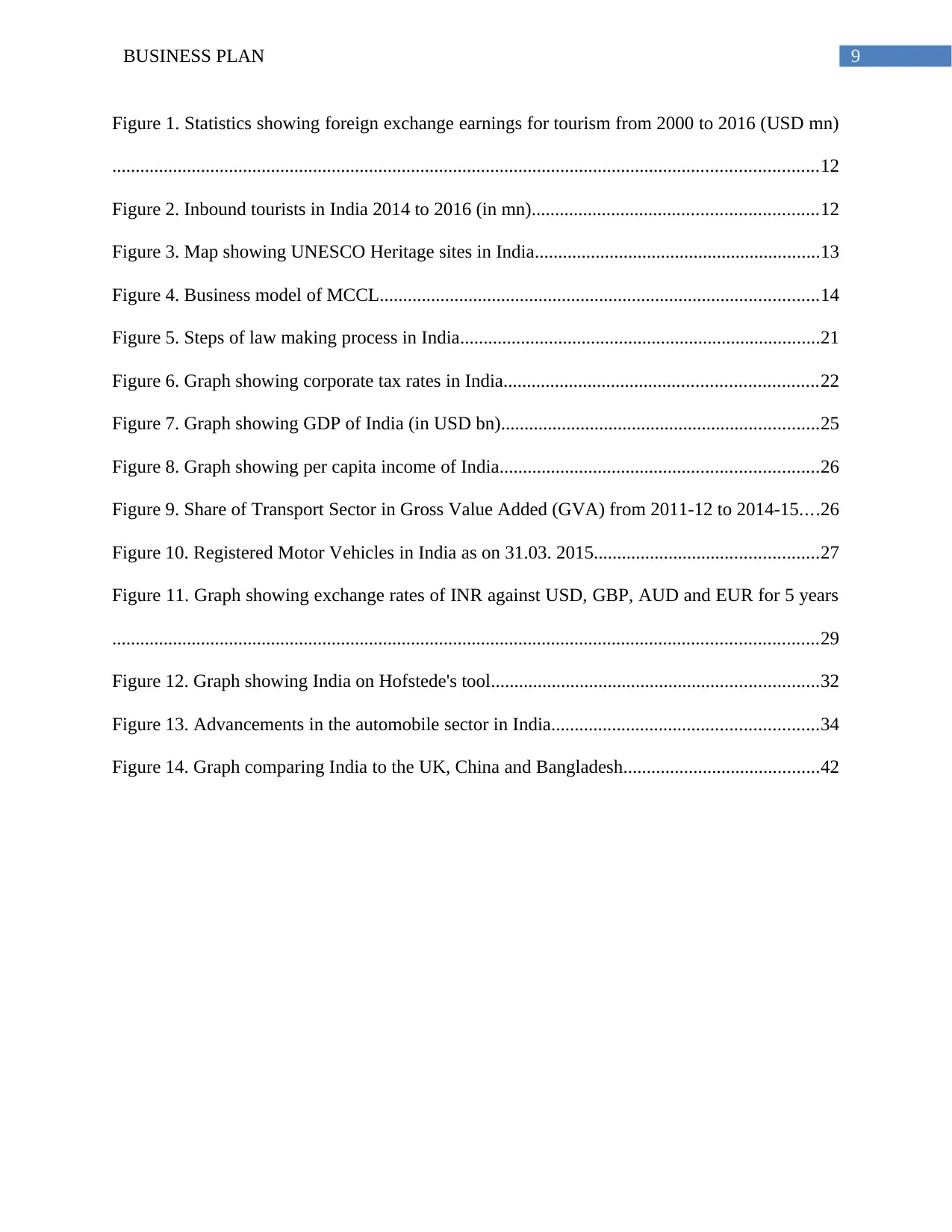
9BUSINESS PLAN
Figure 1. Statistics showing foreign exchange earnings for tourism from 2000 to 2016 (USD mn)
.......................................................................................................................................................12
Figure 2. Inbound tourists in India 2014 to 2016 (in mn).............................................................12
Figure 3. Map showing UNESCO Heritage sites in India.............................................................13
Figure 4. Business model of MCCL..............................................................................................14
Figure 5. Steps of law making process in India.............................................................................21
Figure 6. Graph showing corporate tax rates in India...................................................................22
Figure 7. Graph showing GDP of India (in USD bn)....................................................................25
Figure 8. Graph showing per capita income of India....................................................................26
Figure 9. Share of Transport Sector in Gross Value Added (GVA) from 2011-12 to 2014-15....26
Figure 10. Registered Motor Vehicles in India as on 31.03. 2015................................................27
Figure 11. Graph showing exchange rates of INR against USD, GBP, AUD and EUR for 5 years
.......................................................................................................................................................29
Figure 12. Graph showing India on Hofstede's tool......................................................................32
Figure 13. Advancements in the automobile sector in India.........................................................34
Figure 14. Graph comparing India to the UK, China and Bangladesh..........................................42
Figure 1. Statistics showing foreign exchange earnings for tourism from 2000 to 2016 (USD mn)
.......................................................................................................................................................12
Figure 2. Inbound tourists in India 2014 to 2016 (in mn).............................................................12
Figure 3. Map showing UNESCO Heritage sites in India.............................................................13
Figure 4. Business model of MCCL..............................................................................................14
Figure 5. Steps of law making process in India.............................................................................21
Figure 6. Graph showing corporate tax rates in India...................................................................22
Figure 7. Graph showing GDP of India (in USD bn)....................................................................25
Figure 8. Graph showing per capita income of India....................................................................26
Figure 9. Share of Transport Sector in Gross Value Added (GVA) from 2011-12 to 2014-15....26
Figure 10. Registered Motor Vehicles in India as on 31.03. 2015................................................27
Figure 11. Graph showing exchange rates of INR against USD, GBP, AUD and EUR for 5 years
.......................................................................................................................................................29
Figure 12. Graph showing India on Hofstede's tool......................................................................32
Figure 13. Advancements in the automobile sector in India.........................................................34
Figure 14. Graph comparing India to the UK, China and Bangladesh..........................................42
Paraphrase This Document
Need a fresh take? Get an instant paraphrase of this document with our AI Paraphraser
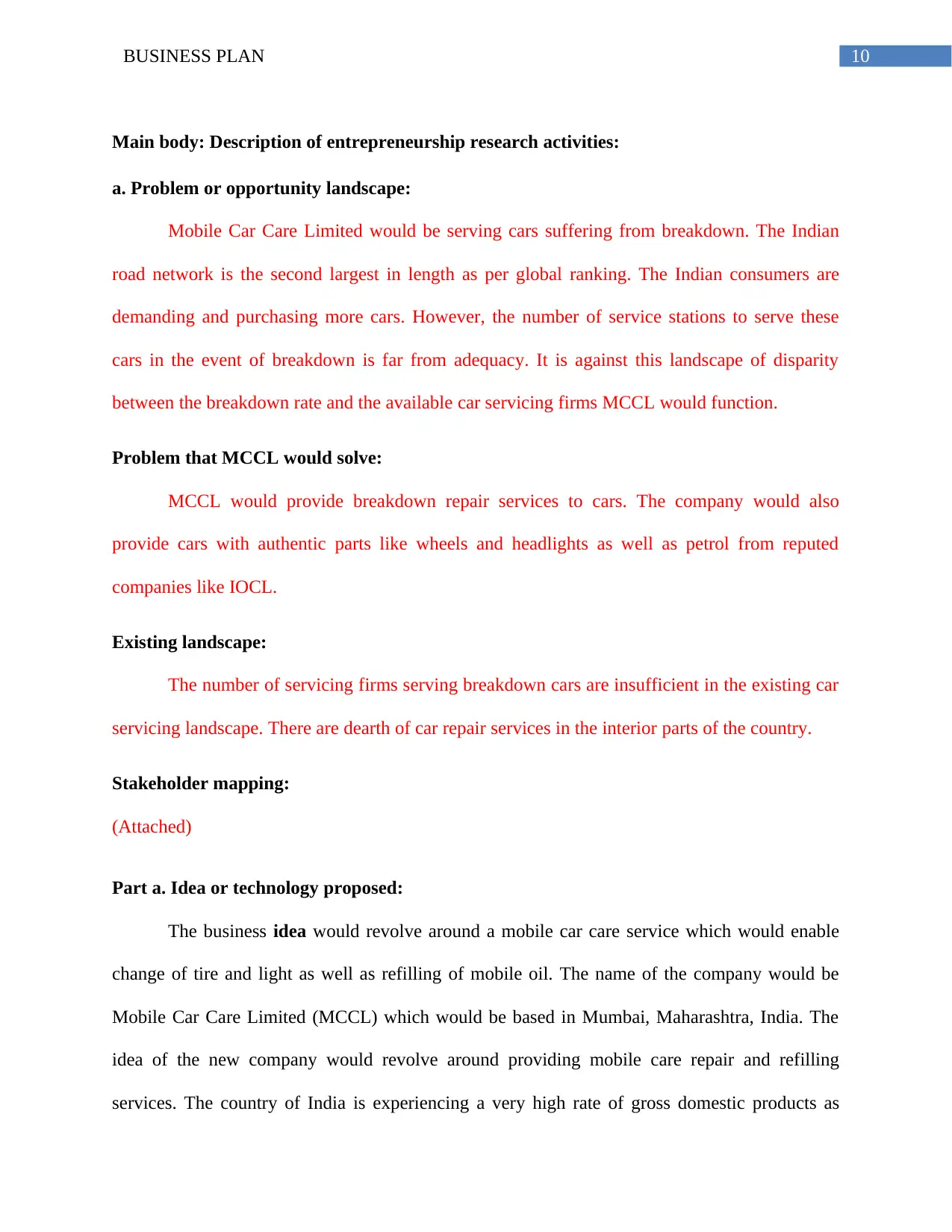
10BUSINESS PLAN
Main body: Description of entrepreneurship research activities:
a. Problem or opportunity landscape:
Mobile Car Care Limited would be serving cars suffering from breakdown. The Indian
road network is the second largest in length as per global ranking. The Indian consumers are
demanding and purchasing more cars. However, the number of service stations to serve these
cars in the event of breakdown is far from adequacy. It is against this landscape of disparity
between the breakdown rate and the available car servicing firms MCCL would function.
Problem that MCCL would solve:
MCCL would provide breakdown repair services to cars. The company would also
provide cars with authentic parts like wheels and headlights as well as petrol from reputed
companies like IOCL.
Existing landscape:
The number of servicing firms serving breakdown cars are insufficient in the existing car
servicing landscape. There are dearth of car repair services in the interior parts of the country.
Stakeholder mapping:
(Attached)
Part a. Idea or technology proposed:
The business idea would revolve around a mobile car care service which would enable
change of tire and light as well as refilling of mobile oil. The name of the company would be
Mobile Car Care Limited (MCCL) which would be based in Mumbai, Maharashtra, India. The
idea of the new company would revolve around providing mobile care repair and refilling
services. The country of India is experiencing a very high rate of gross domestic products as
Main body: Description of entrepreneurship research activities:
a. Problem or opportunity landscape:
Mobile Car Care Limited would be serving cars suffering from breakdown. The Indian
road network is the second largest in length as per global ranking. The Indian consumers are
demanding and purchasing more cars. However, the number of service stations to serve these
cars in the event of breakdown is far from adequacy. It is against this landscape of disparity
between the breakdown rate and the available car servicing firms MCCL would function.
Problem that MCCL would solve:
MCCL would provide breakdown repair services to cars. The company would also
provide cars with authentic parts like wheels and headlights as well as petrol from reputed
companies like IOCL.
Existing landscape:
The number of servicing firms serving breakdown cars are insufficient in the existing car
servicing landscape. There are dearth of car repair services in the interior parts of the country.
Stakeholder mapping:
(Attached)
Part a. Idea or technology proposed:
The business idea would revolve around a mobile car care service which would enable
change of tire and light as well as refilling of mobile oil. The name of the company would be
Mobile Car Care Limited (MCCL) which would be based in Mumbai, Maharashtra, India. The
idea of the new company would revolve around providing mobile care repair and refilling
services. The country of India is experiencing a very high rate of gross domestic products as
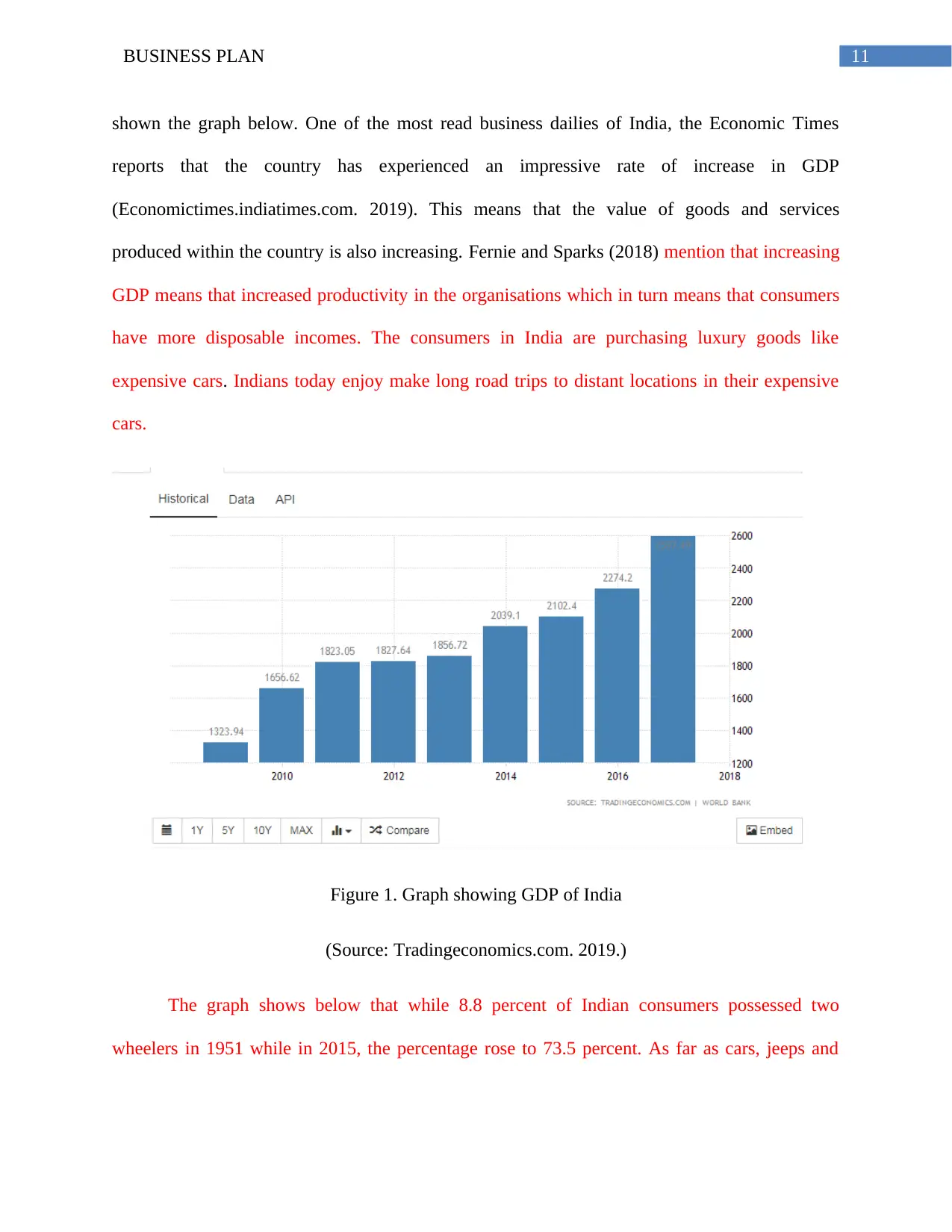
11BUSINESS PLAN
shown the graph below. One of the most read business dailies of India, the Economic Times
reports that the country has experienced an impressive rate of increase in GDP
(Economictimes.indiatimes.com. 2019). This means that the value of goods and services
produced within the country is also increasing. Fernie and Sparks (2018) mention that increasing
GDP means that increased productivity in the organisations which in turn means that consumers
have more disposable incomes. The consumers in India are purchasing luxury goods like
expensive cars. Indians today enjoy make long road trips to distant locations in their expensive
cars.
Figure 1. Graph showing GDP of India
(Source: Tradingeconomics.com. 2019.)
The graph shows below that while 8.8 percent of Indian consumers possessed two
wheelers in 1951 while in 2015, the percentage rose to 73.5 percent. As far as cars, jeeps and
shown the graph below. One of the most read business dailies of India, the Economic Times
reports that the country has experienced an impressive rate of increase in GDP
(Economictimes.indiatimes.com. 2019). This means that the value of goods and services
produced within the country is also increasing. Fernie and Sparks (2018) mention that increasing
GDP means that increased productivity in the organisations which in turn means that consumers
have more disposable incomes. The consumers in India are purchasing luxury goods like
expensive cars. Indians today enjoy make long road trips to distant locations in their expensive
cars.
Figure 1. Graph showing GDP of India
(Source: Tradingeconomics.com. 2019.)
The graph shows below that while 8.8 percent of Indian consumers possessed two
wheelers in 1951 while in 2015, the percentage rose to 73.5 percent. As far as cars, jeeps and
⊘ This is a preview!⊘
Do you want full access?
Subscribe today to unlock all pages.

Trusted by 1+ million students worldwide
1 out of 65